The Galapagos Islands have been on our bucket list for quite some time. In addition to the unique flora and fauna on land, large marine life is abundant making the Galapagos one of the world’s top diving destinations. We met a group of Thai divers (Montana and Pap) on a trip to the Red Sea in 2017 and found out that they had chartered a dive boat for a week in July 2018. When 2 spots opened up, and we had recently returned from Patagonia without another trip in the works, we jumped at the opportunity to join.
It’s quite difficult to secure a liveaboard spot in the Galapagos, since very few boats are permitted, and hence prices are substantially more than for other dive trips. However, the general consensus among divers is that the experience is well worth the money. We had recently crossed the 100 dive threshold so we felt prepared for the more challenging conditions (cold water and strong currents). The MV Humboldt Explorer also offered several land excursions for a comprehensive experience of the famous archipelago.
Our itinerary:
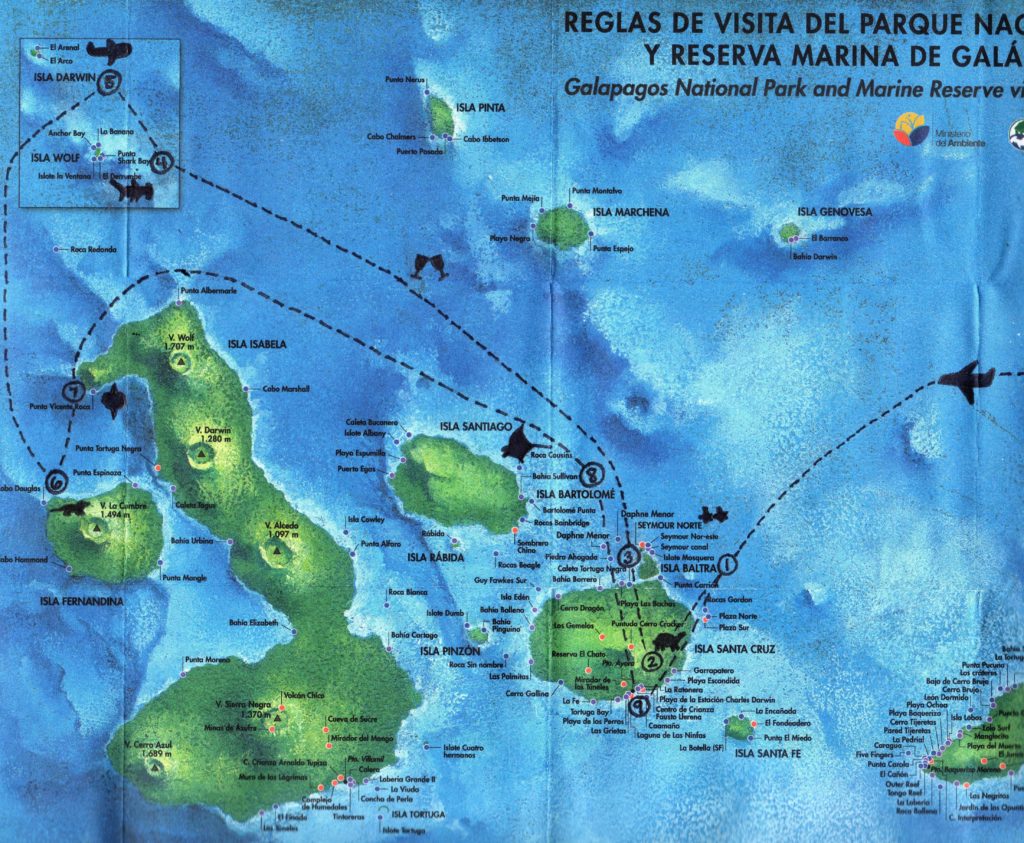
1: Flights and Arrival
We chose to fly into and out of Baltra (GPS) airport near the island of Santa Cruz, home of the Galapagos’ largest population center. We also had the option of flying out of San Cristobal (SCY) at the end of our trip, but found cheaper flights and better connections out of Baltra. Note that there isn’t much flexibility in flight times to the Galapagos – all flights generally arrive in the mid- to late-morning and depart no later than 1 PM.
The airport experience was relatively easy, as the Galapagos are used to handling large numbers of visitors. We fortunately had sufficient cash on hand to pay the $100 per person park entrance fee upon arrival (which also came with a unique stamp in our passports). That was in addition to a $20 per person fee before departure from Quito; we’re not quite sure why they were separate but this one looked official with a paper “visa” keepsake. The checked bags were subject to a K9 inspection to prevent introduction of non-native products. Buses then transported passengers to the channel separating Baltra from Santa Cruz island, where one would normally take a water taxi across for transfer to the main city, Puerto Ayora. Our liveaboard was moored in the channel so we were picked up with a “panga” (dinghy) to drop off our bags and grab lunch on board.
2: Tortoise Tour
The boat wasn’t departing until the next morning so we headed to Santa Cruz island to see the endemic giant land tortoises. They are allowed to roam freely on the island, among people and farm animals, and we visited a ranch on which they’re frequently seen. We took a walk on the green fields to observe the turtles eating or resting. We saw several dozen of various sizes on our ~1 hour visit. The park’s namesake creature can be found on multiple islands with slightly different features, most prominently the shape of the shell, as a result of adapting to their habitat. They are generally not afraid of humans but make a hissing sound if approached too closely.
Following the tour, we headed back to the boat where we were joined by the rest of the divers and crew for dinner. There were 16 divers in total (all Thai except us), 2 dive guides (Paulo and Alex), and 8 other crew members.

3: Baltra & North Seymour
We woke up at 6am for our first dive briefing of the trip. We would be doing two checkout dives to ensure that we were correctly weighted and to get comfortable in our thick 7mm wetsuits, hoods and gloves. The conditions on the subsequent days would include strong currents and large waves on the surface, so it was important to get the equipment dialed in prior.
We dropped down in an area called Punta Carrion. The visibility was ok and there wasn’t much to see other than large lava rocks, starfish, tiny blue nudibranchs and turtles. We did get our first glance of a Galapagos sea lion playfully swimming beneath us on our safety stop. We were also pleasantly surprised that the 70 F water temperature was manageable in our gear, as we had been dreading the cold waters.
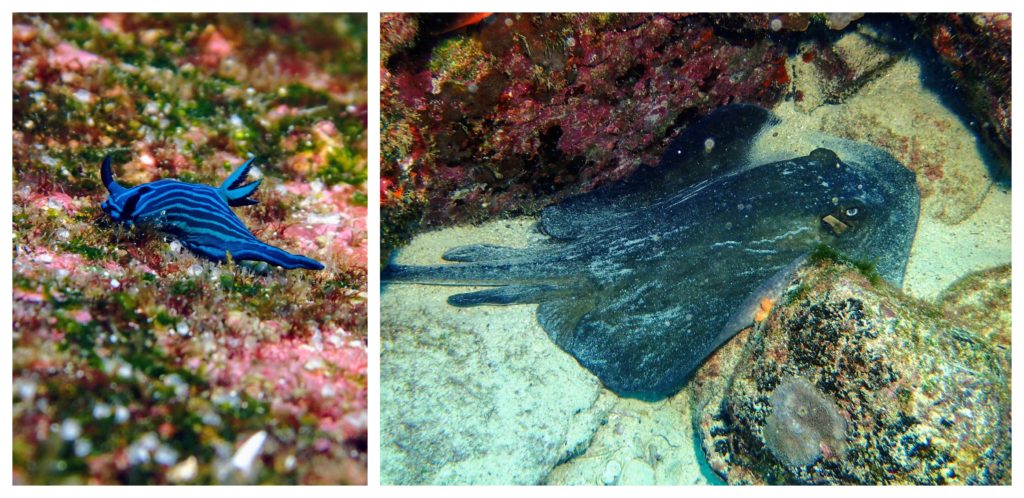

Afterwards we had to settle up on fuel charges, nitrox, the land tour to see the tortoises, and a last minute change to the trip route. These were all unexpected charges so we didn’t get enough cash out beforehand, but fortunately Pap offered to lend us what we needed to avoid the steep 18% surcharge for credit cards. After paying an arm and a leg for an already expensive trip, we decided that we needed to make it worth it and popped open the wine, which was luckily included in the trip.
The first diving day of the trip also included a land tour on North Seymour. After we finished lunch, Mauricio, our naturalist guide, took us on land. There were a number of nesting blue-footed boobies and frigatebirds, land iguanas and lava lizards, and sea lions. All animals could be approached quite closely without being frightened, some literally nesting with their newborn a foot away from our path. We learned that frigatebirds steal food from boobies and pelicans because they’re unable to get their own; they lack an oil which is necessary for removing the salt when diving into the water. We saw this in action as a boobie arrived to feed his baby and was immediately swarmed by a number of frigatebirds. We were also surprised by a male iguana chasing after a female just ahead.
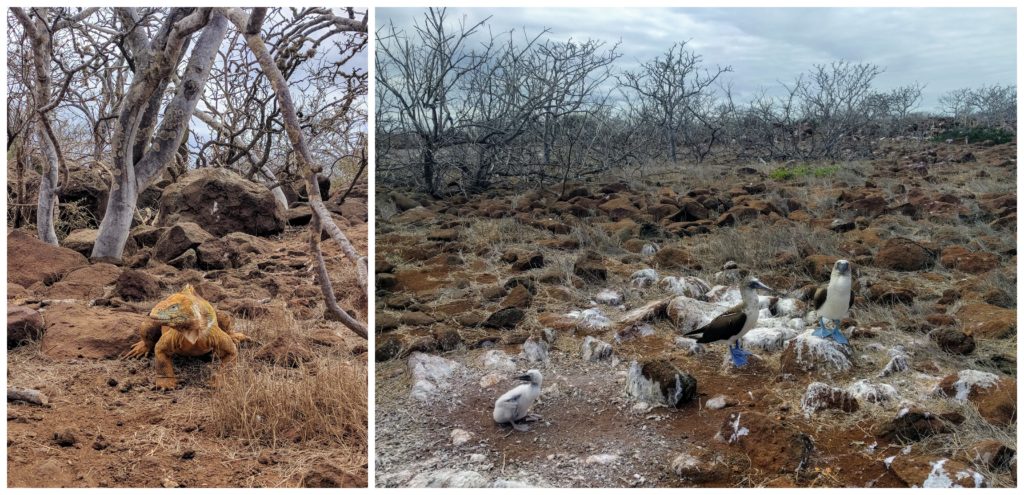
After completing the land tour, the party continued. We had a 12+ hour journey to get to the remote Wolf island, and the weather was great, so the wine was flowing freely on the top deck. It was a booze cruise with Thais, Americans and Ecuadorians exchanging their favorite stories. We even got Thai nicknames in the process: Aktid (sun) for Nico and Dau (star) for Britt. Everyone called it an early night shortly after dinner as four dives were planned to commence at 5:45am the next day.
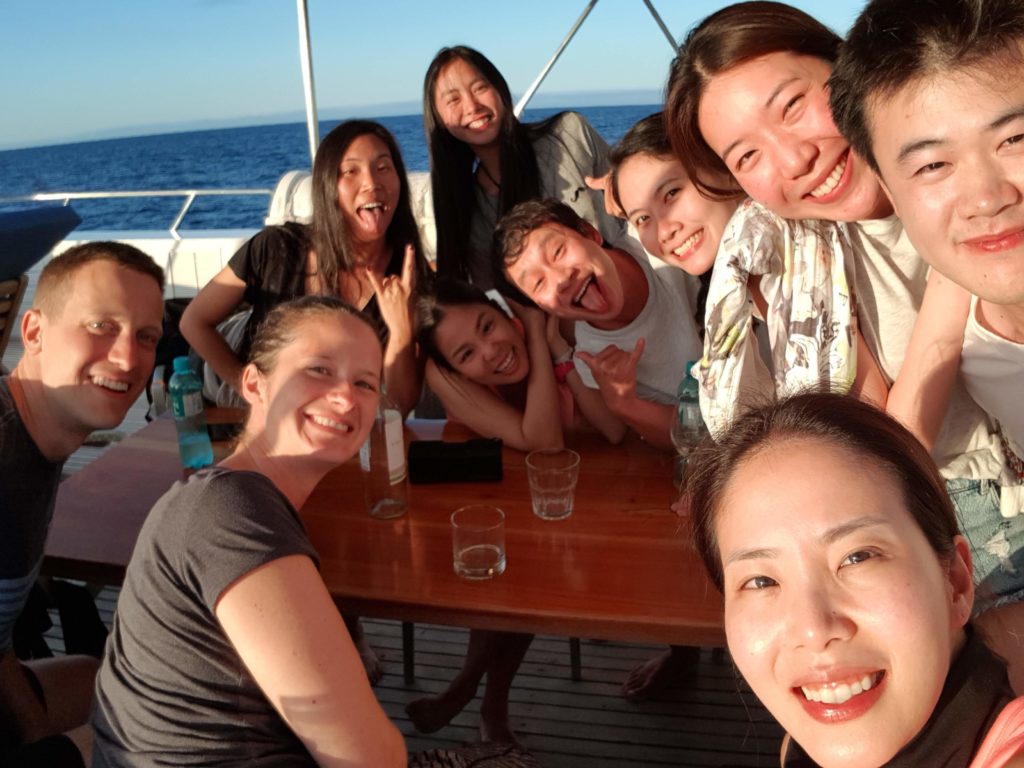
4: Wolf Island
Wolf and Darwin was the main event for diving. The islands lie north of the main archipelago at the intersection of several major oceanic currents bringing nutrients and an abundance of life to the area. On the top side, the islands were jam packed with red-footed boobies, many of which came to hang out on the boat’s deck (one would go on to poop on Dau… but she was told this was lucky).
The tone for the type of diving we would embark on was set with the first panga ride. It took 3 crew members to hold the dinghy close to the boat and stable enough for divers to get on in the choppy conditions. Everyone was left slightly seasick after the 5 min ride to the dive site. This was combined with mild anxiety about the strength of the currents below. The gear was double- and triple-checked, and after a “1-2-3-Go,” we rolled into the water and quickly descended.
Fortunately the current wasn’t insane and our queasy stomachs quickly felt better. We descended to a platform around 70 feet, found a suitable rock, and clung on (gloves mandatory) to watch the show in the blue.

There were many highlights over our six dives at Wolf Island, split between the Landslide and Shark Bay sites. We saw in excess of 100 hammerhead sharks, sometimes in large schools and often up close and personal. We were circled by majestic groups of spotted eagle rays. And we saw our first ever whale shark, a large pregnant female passing above us.
5: Darwin Island
Darwin island is a two hour boat ride from Wolf. There is only one dive site called Darwin’s Arch where we were told that it would be possible to see whale sharks on almost every dive. And, after six dives here, we successfully saw one, if not more, on each dive. For some, the guides pointed them out from the depths where they seemed to appear out of nowhere but then were hard to miss because of their massive size. During one particularly memorable dive, it had been about 30 relatively boring minutes and many divers were preoccupied with taking pictures of the macro (small) life and not expecting to see more than the occasional hammerhead. However, from the ledge on which we were perched, a huge whale shark glided slowly past. We felt like pedestrians on a sidewalk as a 45 foot long school bus passed.
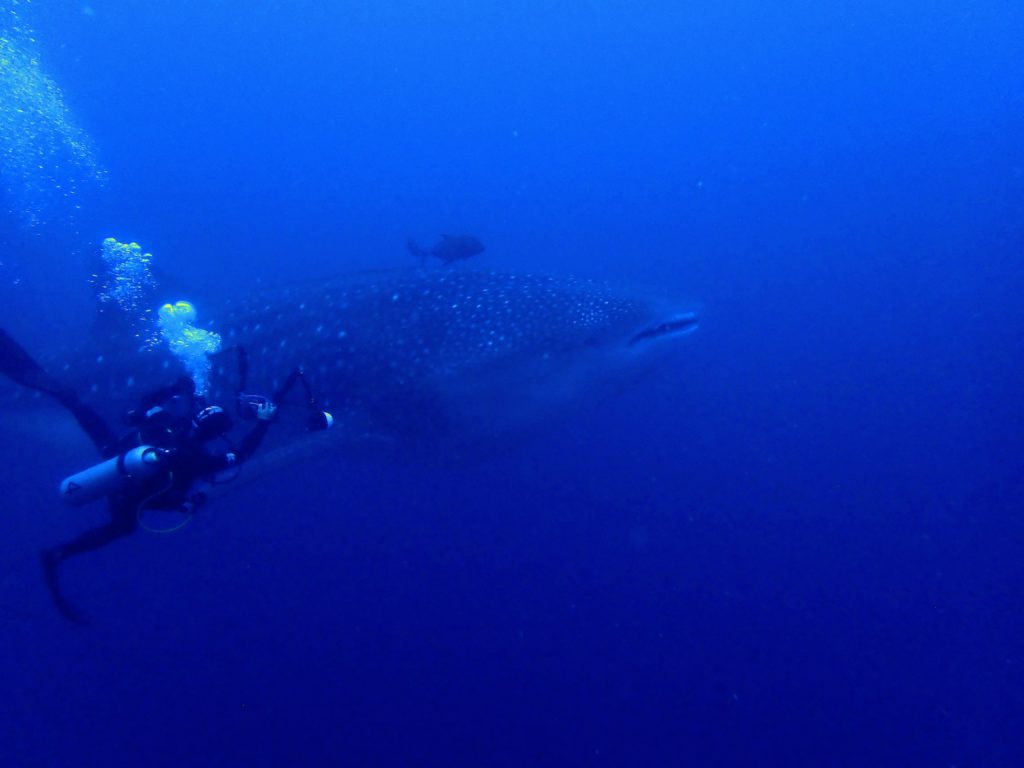
Bottlenose dolphins also called Darwin island home – we often saw pods from the boat, in front of and alongside the pangas, and we were lucky to see them occasionally at the beginning / end of dives.
It was easy to tell the ecosystem was healthy and that there was an abundance of sea life. It was incredible to be circled by a tornado of bonitos (tuna), all moving in synchronization. The Galapagos sharks, a species related to the black tip, were inquisitive of the bubble-making creatures.
At the end of the final dive at Darwin, we took the pangas up close to the famous arch for some group photos.
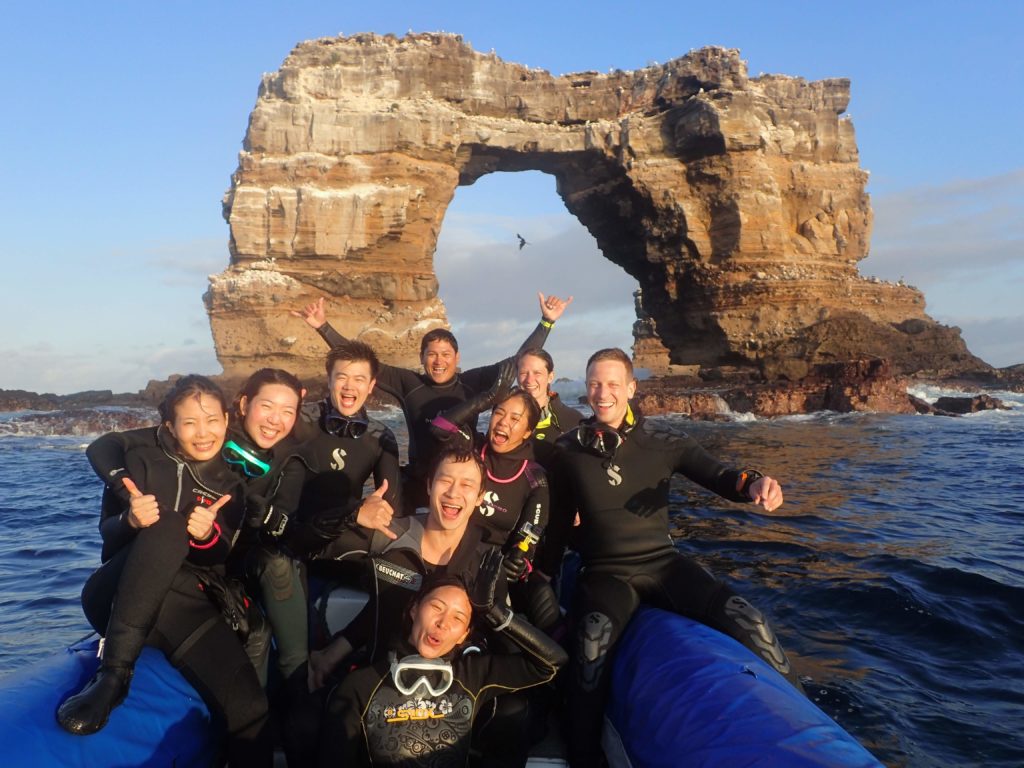
6: Cabo Douglas, Fernandina
After cruising through the night, we arrived at the archipelago’s youngest island at less than 1 million years old, Fernandina. After breakfast, we hopped into the panga for a tour of the shoreline.
What initially looked like black rock, upon further inspection, revealed to be large groups of marine iguanas, a species of iguana that has adapted to swim in order to eat algae off the submerged rocks. They were lounging on the rocks to warm up before diving in for their mid-day meal (or so we thought).
We also spotted several flightless cormorants among the black lava rocks. As a result of being extremely good at diving for fish and not having land-based predators, these birds have lost their ability to fly and instead have denser fur to keep them warm in the water. After hunting for seafood, they could be seen air-drying their stubby wings on shore. Swimming nearby was one of the cormorants’ distant cousins, the Galapagos penguin, the only one if its kind to be found anywhere near the equator.
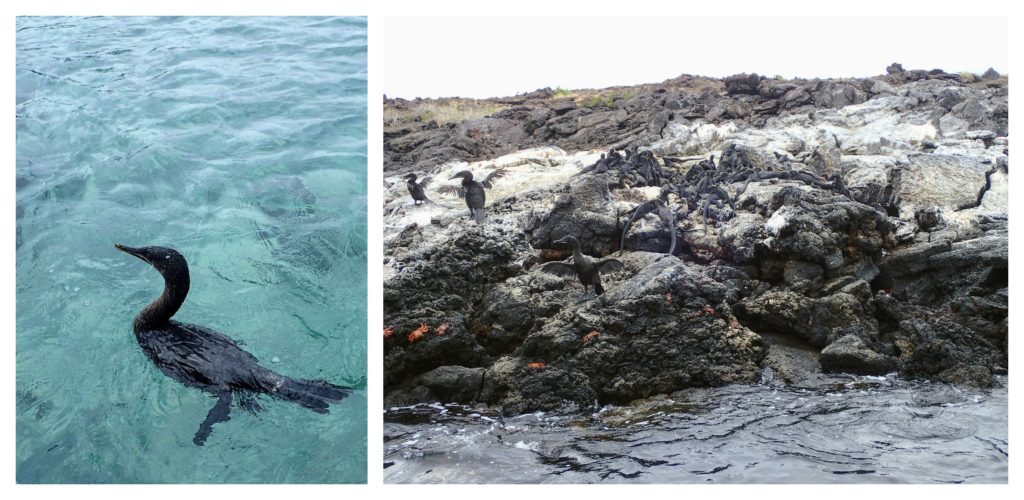
Part of what allows the penguins to survive at the equator is the cold water brought to the island by the northerly Humboldt Current. In fact, there was more than 10 F difference in the water temperature compared with Darwin and Wolf islands, something quickly felt once jumping in! The purpose of the dive was to catch a glimpse of the marine iguanas feeding on the algae. Unfortunately they weren’t hungry or warmed enough that morning due to the lack of sun, but we were joined by a few sea lions in the shallow waters.
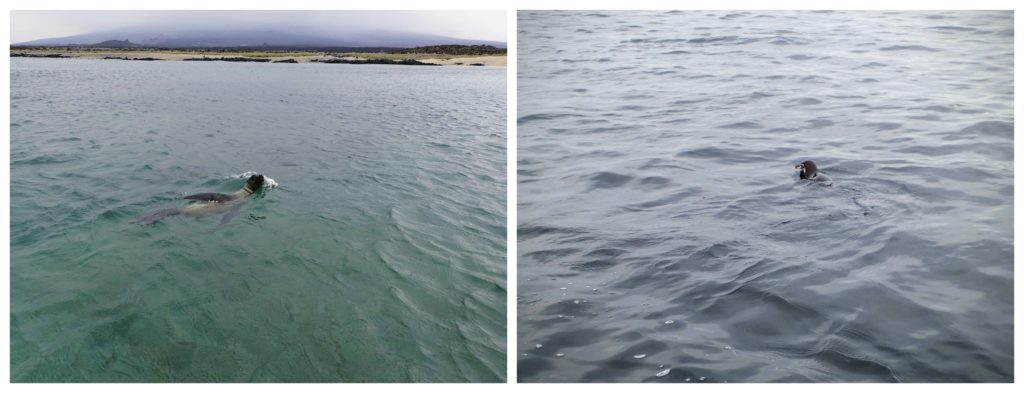
7: Punta Vicente Roca, Isabela
A few hours’ boat ride from Fernandina took us to the northwestern part of Isla Isabela, the largest island. The objective of two dives here was to find the mola mola sunfish. One of the strangest fish in the sea, the mola mola resembles a vertical pancake with fins and can weigh over 2000 lbs.
We descended into murky water similar to pea soup. After 15 feet, the visibility became crystal clear and the temperature dropped to a chilly 62 F. After continuing to the sandy bottom at 70 feet, we quickly spotted a pair of mola mola near us. The shape and swimming motion of these fish is quite surreal. We looked on for a few minutes and then found another pair shortly thereafter. By this time, the cold had gotten to us (Brittany) so we headed to the surface after 25 minutes.

8: Bartolomé
The last dive of the trip, of 17 in total, was around Cousin rock near the islet Bartolomé and island Santiago. We weren’t expecting any big creatures, but happened to get lucky anyway and spotted 4 Manta rays throughout the dive. We also saw another playful sea lion and the best macro life of the trip, like a large, orange Pacific seahorse.
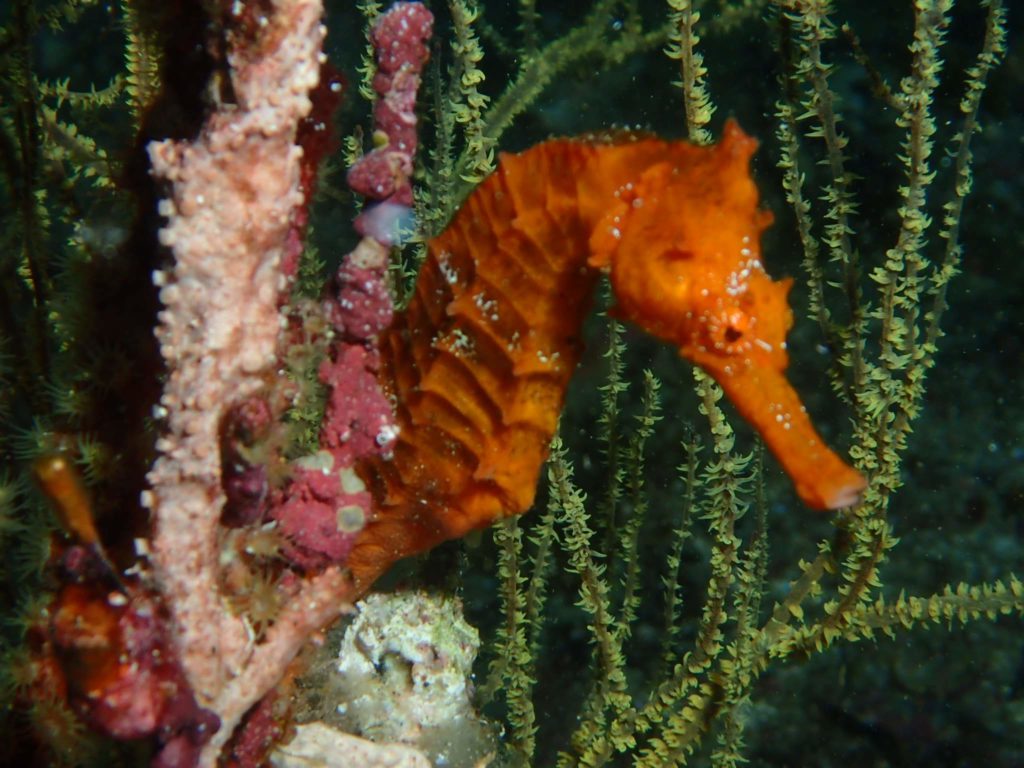
After the dive, we took the pangas to Bartolomé for a land tour of a rather Martian-like landscape. There were only a few types of cacti, lava lizards and grasshoppers that called the islet home. The highlight was the vantage point from which we could see a number of the neighboring islands, both nearby and off in the horizon.

9: Puerto Ayora
We chose to hop off the boat at Santa Cruz island rather than continuing on to San Cristobal, since this allowed us to see the town and because the flights were cheaper. We didn’t have long in Puerto Ayora but didn’t feel like we needed more time. The small town thrives on the tourism industry and the streets are lined with various souvenir shops and day tour agencies. We appreciated being on land and that our quaint hotel put a lot of care into sustainability while still maintaining a good level of comfort.
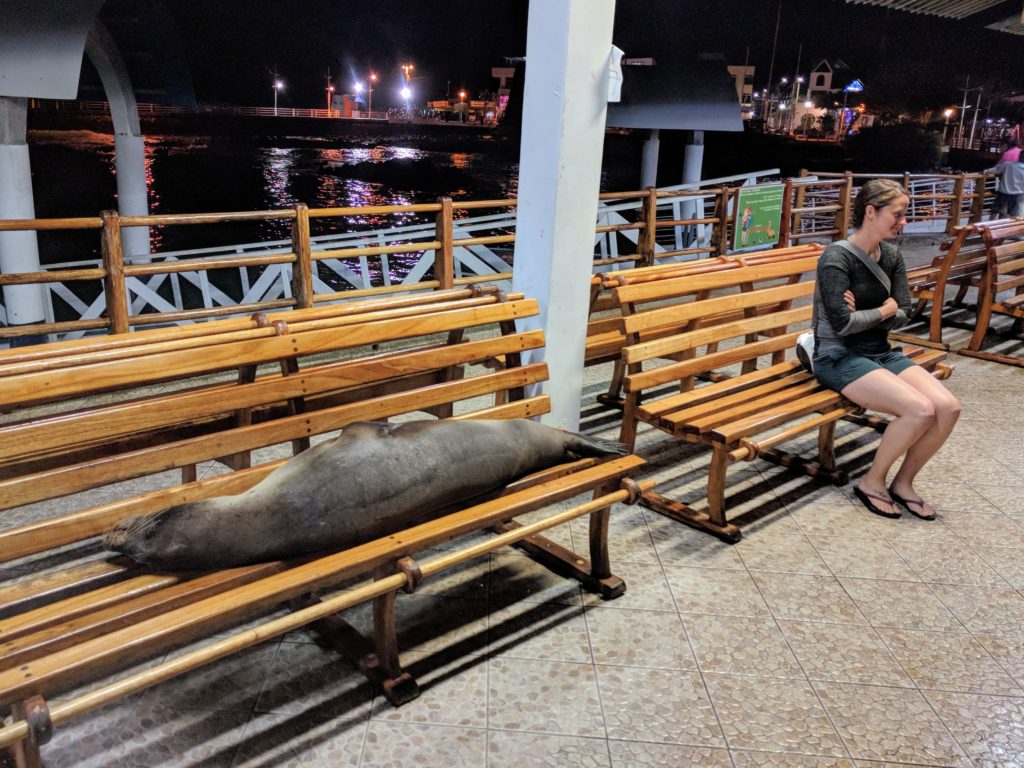
At the recommendation of our naturalist guide from the land tour on Bartolomé, we headed to a street in town that closes to traffic and becomes a plaza for the local food stalls cooking up fresh caught seafood. It happened to be lobster season so we explored a few options with Pap, Montana and Liew – the lobster spaghetti, ceviche and tuna were highlights. After dinner, we strolled around and then called it an early night as everyone was excited to sleep in a real bed.

Reflections:
For big animal action, the Galapagos was hands down the best destination we’ve visited. We were hoping to see a whale shark and got to see 15 in total, all of them huge pregnant females. We only saw another group of divers once underwater out of 17 dives. The limitations on the number of dive operators, and the sheer remoteness of Darwin and Wolf, keeps the sites pristine. The divers in our group, 8 in total, were a “dream team;” everyone had at least 100 dives worth of experience and used nitrox, so we were able to maximize our bottom time.
Overall, we struck a good balance of land and sea adventures. Diving was the main event but we also visited many of the topside attractions, including the boobies, iguanas, and tortoises, in a small group setting with a naturalist guide from the park. We saw a few 100+ person cruise boats along the way which were ferrying boat loads of people back and forth from the land attractions – that would have been too much of a cattle feel for us. Our recommendation to others considering a visit would be to dive, if you’re certified and sufficiently experienced, or otherwise choose a small cruise boat that goes all the way to Isabela and Fernandina, to get a good variety of land excursions.
For our next diving trip, we’ll probably switch up the scenery for soft corals and macro life. The Philippines, Maldives or Sipadan are sounding pretty good. Any suggestions? We’ll also need to make a trip back to Thailand to reconnect with the many friends made aboard the Humboldt Explorer.
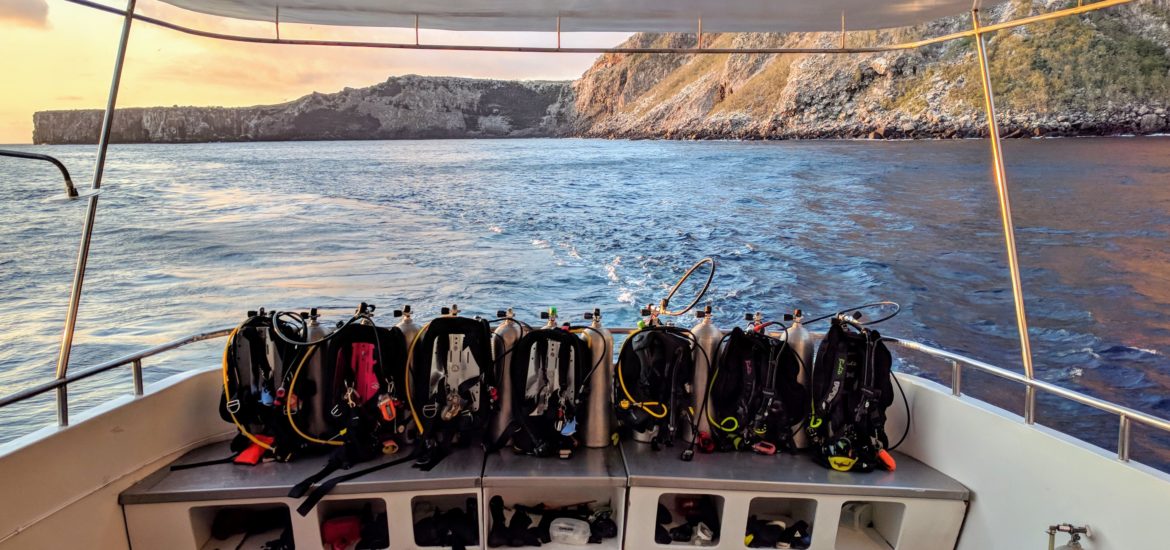
Hi! I could have sworn I’ve visited this blog before but after browsing through some of the posts I realized it’s new to me. Anyhow, I’m definitely delighted I came across it and I’ll be book-marking it and checking back often!